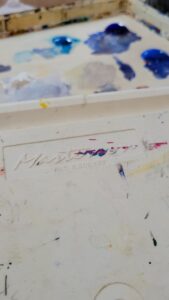This article appears in the Fall, 2023 issue of SAGE-ING magazine http://www.sageing.ca/
Five Art Class Tool Essentials
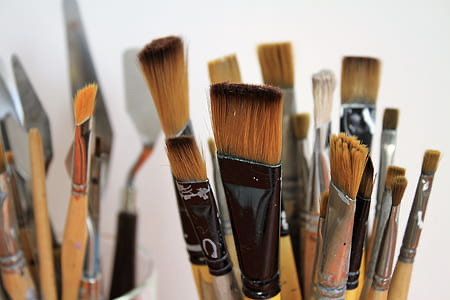
Have you been thinking of taking an art class? You’re no doubt wondering: ‘Where do I start?’. Do I have to know how to draw before I try to paint? I can’t even draw a stick person! I can’t draw a straight line! These are questions and quotes I have heard often. The answer to these questions is, no, you do not need to know how to draw before you try to paint. I don’t draw stick men very often either, so I think you will do just fine. Straight lines can be drawn with a ruler. There is no reason why you should put up these roadblocks if you really want to learn an art form. Wanting to learn is the very first step as it opens your mind to the adventure you are about to begin.
Where do I start? The first step is to decide which medium appeals to you: acrylic, oil, or watercolour paint, or drawing with pen and ink, pastels, mixed media, pencil, charcoal, and so on. Then you put it into action. Find out if there is an instructor nearby. These days it is much easier with the many online courses offered. If you’re hoping to take one of my online art classes, you can find out more about them here. Then you stop by your local art supply store. It is often thought that the supplies will cost more there, so you might try going to a big box store for supplies instead. However, here is what happens when you start there: First, you will get no help from staff because they do not know how to use the supplies they sell. Second, you will pay more because you will have to go shopping again for the better supplies that you actually need. In this article, I will be giving you some information on painting with acrylics.
I can understand why an art supply store can be overwhelming. I was 18 when I first went shopping for my own paint. I lived in a remote community when I was younger and my grandfather used to pick up my supplies for me. The very first thought that came to my mind was, ‘why did my grandfather only buy me 5 colours?’ They were Ultramarine blue, Cadmium Red medium, Cadmium Yellow medium, Titanium White, and Ivory Black! There were so many more colours available in the store! The display was beautiful. It was so inspiring to see all those colours. All the brushes looked perfect, and I hadn’t known that there were so many choices. ‘How do I decide?’ I spoke to some of the knowledgeable staff and they helped me out. I asked my grandfather why he had chosen only those colours when he bought me supplies. He responded, “I asked the guy in the art supply store and he said that this is all she needs to practise mixing colour if she wants to be a real artist.” That was the best advice he could have given my grandfather to get me started. What I have learned about mixing colour has given me an advantage ever since. I began to explore all of the colours, and that experience has helped me become the artist and instructor I am today. I could not stop exploring. I was completely hooked on colour.
Tell them you are a beginner. The art supply store staff will get you started on the right track. If you are taking an art class, get the supplies that the instructor recommends. They know those supplies well and are recommending them for a reason. Your first reaction when you look at the pricing will perhaps scare you. Make sure you ask the instructor if there is a student grade recommendation that will give you similar results. Most instructors will be able to guide you in the right direction for a comparable brand. If not, the staff at the art store can help you out. I do not recommend you go with the lowest grade of supplies. You will be frustrated as the paint and the surface will prevent you from achieving the desired results. You do not need that frustration when you are starting out. There are so many things that you are trying to learn that you don’t want your supplies to cause you to adapt to a different technique than what is being taught. If you decide on a student grade, go for supplies in a mid-price range. You will be happy you did. Eventually, you will want to purchase better-quality paint.
Once you are all set to start, now comes the big question. What do I use as my first subject to paint? Use one of your own photos. Paint something you are familiar with. It is more fun to paint something you know. Landscapes are a great starting point as they are more forgiving. You will also learn all the elements of design that you can carry forward into other works.
Now that you’re well on your way to creating your first painting and itching to book your first art class, you’ll need to check that you have all the right materials to get started.
Here Is A List Of The Five Art Class Tool Essentials For Painting With Acrylics:
#1. Paint
Start with a limited palette:
- Ultramarine Blue
- Cadmium Red
- Cadmium Yellow
- Titanium White
You do not need black; you can mix your own. In addition to the colours above, I have these reds, blues, and yellows on my palette:
- Cadmium red light, Cadmium red deep, Pyrrole crimson
- Cobalt blue, Cerulean blue, Manganese blue
- Cadmium yellow light, Yellow Orange Azo
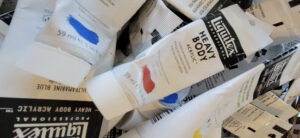
I like Liquitex® HEAVY BODY® Acrylic paint for its flexibility in the various styles I work in. Liquitex® has a student grade paint called, ‘Basics 101’.
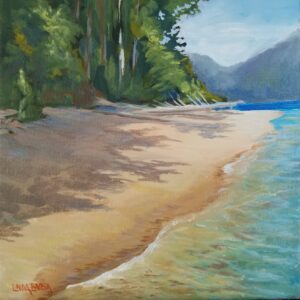
Slocan Lake Beach ~ Linda Lovisa
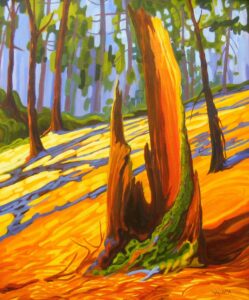
Drought Mountain ~ Linda Lovisa
Both of these paintings were painted using the palette of colours mentioned earlier.
Mixing colours can be so much fun!
#2. Brushes
My favourite brushes are a ¾” flat synthetic medium stiffness and a ½” flat synthetic – but I have several sizes. Round brushes in various sizes; 3, 5, 6, 8, 10 (different manufacturers number their brushes differently). Your choice depends on your touch, soft to medium if you have a light touch. If you have a heavier touch, perhaps a bristle brush is best suited for you. You will find that you will need all kinds of different brushes depending on what you are trying to accomplish. You will find a favourite brush. How do you know it is your favourite? It is the one you search for every time you paint. When you do, buy several of the same size and try a few different brands in that size. There’s nothing worse than needing to replace your favourite brush and you can’t find one!
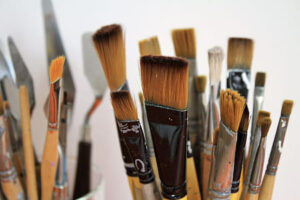
#3. Palette
The Matheson Sta-Wet® palette is the best thing you will ever purchase for painting with acrylics. It will save you a lot of money. No more throwing paint away! The palettes come in different sizes. I suggest purchasing a larger one. It is nice to have room for your colours.
#4. Sketch Pad And Pencil
It is very handy to have a sketch pad and pencil to write notes about different colour combinations, practice your drawing skills, sketch your subject, test colour swatches, scribble and doodle warmups!
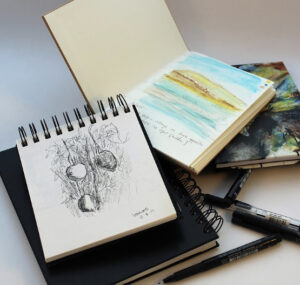
#5. Canvas, Water Container And Rag
Please buy a good student grade canvas even if you are just starting out. Otherwise, you will be sorry you didn’t when that paint you apply just keeps disappearing into the weave. Your art supply store will have some options for you. Do not buy a huge canvas! No larger than 12” x 16” when you begin to paint, as larger sizes can be overwhelming. Get some experience first! You can then tackle that big one you want for the wall behind your bed.
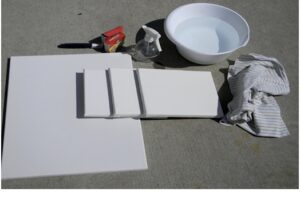
I hope this information helps you have many wonderful painting experiences and helps you feel prepared for your first art class. If you’re curious about taking an art class with me, click here for more information about my online art classes.
written by Linda Lovisa
The Art of Scribbling, by Linda Lovisa
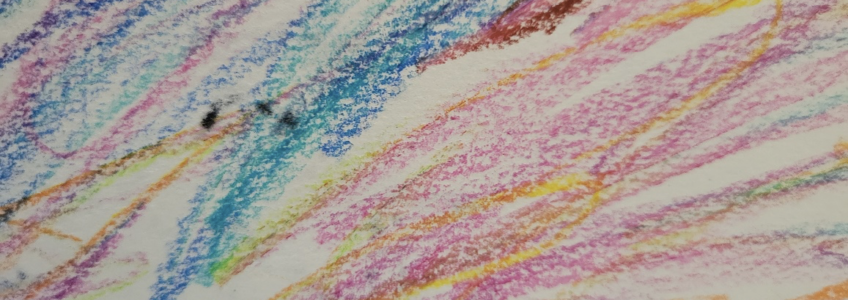
As children, the first thing we do when we are given a pencil is scribble. It helps develop hand-eye coordination. It is a way of communicating through lines. Most scribbles at a young age are up and down lines, some joining, others are disconnected. As the child gets used to how to hold the pencil, they begin to explore more shapes such as circles. Lifting the pencil and repeating the shape in another location on the page and gaining control of movement.
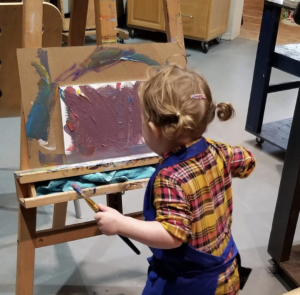
When colour is introduced, there is excitement and energy that engages a whole other sensory system in the brain. Every time you introduce a new implement, such as markers, crayons, coloured pencils or paint they will often revert back to just lines of scribble until the colours are explored. The child will then go back to those familiar movements and introduce them in colours that appeal to them. It is so interesting to see which colours they are drawn to. Most often, as the child ages and is given the choice, the t-shirt colour they’d chose could be traced back to the dominant colour they chose when scribbling. Scribbling is also a very good way for a child to deal with stress, anxiety, anger and depression. When you scribble, it helps release emotions you are feeling at that moment.
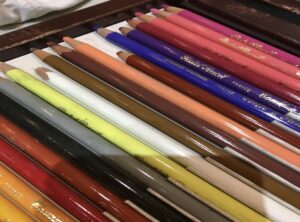
An older child may spend some time drawing a picture, scribble it and crumble. If this should happen, here is a suggestion for you. What I have done in the past is to open it up carefully, showing respect for the effort and discuss all the positive aspects of the drawing. Encourage trying it again. Reassure the child that it is practice that will get the result he or she is looking for. Try and try again. There is always a positive within a negative. Re-enforcing the positive goes a long way. I believe scribbling should be a daily activity. Leave a stack of papers and a tin of crayons on the coffee table in front of a television, it is only a matter of time before you notice your child engaged in scribbling or drawing. Now, this is not from a scientific journal. These are personal observations I have made over the years with my own children, grandchildren and students I have had the pleasure of teaching.
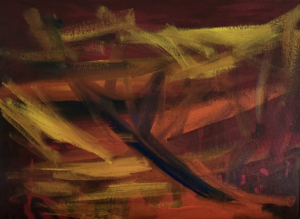
Scribbling for Adults?
It has been several years now since colouring books have come into vogue. Some are more complicated than others. They are an art form in themselves. Did you know that scribbling on a piece of paper and colouring in the shapes are just as therapeutic and cost a whole lot less? Scribbling as an adult is just as beneficial as when you were a child. Scribbling is freeing! It is acceptable to scribble however you feel. Nobody can scribble badly. Quick scribbles and methodic scribbles are equal. Scribbling is a form of expression. I find a good quick scribble with no planning, just let it happen, is great stress relief and a way to warm up before creating a drawing or preparing to paint. Especially if it is one that I have not worked on in a little while. I always have several works on the go, so a good scribble is how I get back into it.
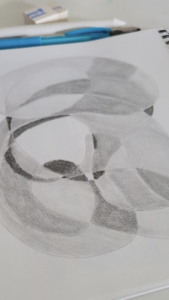
I have a scribble canvas. This is a canvas that at some point I decided I was not going to continue as a painting. It then becomes a scribble painting. Quite abstract I might add. All kinds of colours end up on the scribble canvas. Sometimes I see something in the scribbles and I carry it on as a painting. At that point it should be sold by the pound, laughing out loud.
I also use scribble sketching to teach about values. Using a pencil, shading the various shapes in the scribble, light, medium and dark helps to train your eye. It also helps you learn how much pressure you should put on your pencil to achieve the various shades. It is a great exercise if you are new to drawing. It is a safe environment and you will be very surprised as to how this exercise trains your hand-eye coordination.
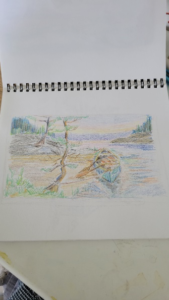
Whether you are scribbling with paint, coloured pencils, ink, markers or a simple pencil, the results are the same. You are engaging your brain in a different way. Creating new pathways by engaging in something new. You are keeping the brain healthy, active and stimulated. A scribble a day may keep the doctor away. Put scribbling into your daily routine. There is always time for a scribble. Coffee, tea and a scribble is a great way to start your day!
Linda Lovisa
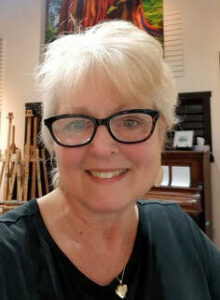
How Do You Become An Art Teacher?
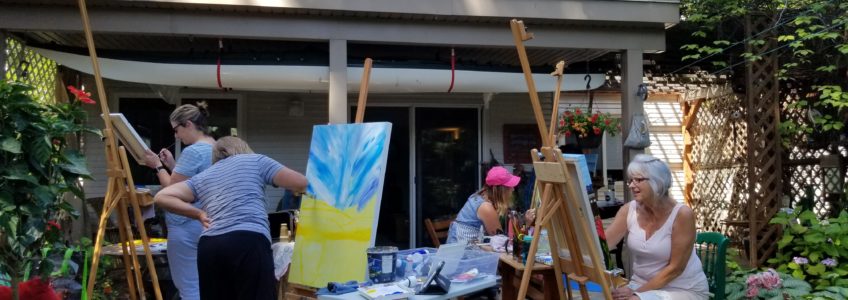
This is a very good question. Becoming an art teacher is something very special. You are imparting your knowledge to students of all ages. Whether you are teaching an on-going class or a weekend workshop, you are an influence on that person’s growth as an artist.
How you get there is always an interesting story. It is different for everyone. Some choose university to pursue a fine arts degree and others just get chosen because of the things they do. Volunteering at schools, summer camps, museum art programs, Girl Guides and Scouts’ groups; the list goes on. The latter is how I got started.
The late Pierrette Dulude Bohay was my mentor in my early 20s, she told me, “Share what you know. If you don’t know, find out, try it and share your results.” Those words put me on track to becoming a teacher. That has stuck with me throughout my career as an artist, mentor, and as a teacher.
How I Became An Art Teacher
My very first teaching experience happened in an unexpected way. I had moved from Ottawa to the small community of Devlin in Northwestern Ontario. I was at the country store picking up a few items. The clerk introduced herself and welcomed me to the community. Like most small towns, when you have a new arrival, you ask all kinds of questions so that you can inform the next person who shops a bit of information on the newcomers. Our family was the new topic of the week. “What do you do?”, asked the clerk. I am a stay-at-home mom and an artist. “Really?!” she replied with excitement! “Could you teach a group of us to paint?” I was caught off guard. I had never been asked to teach before. I responded with, “My house is very small. I wouldn’t have room.” “Not to worry; we have an old school house we can use for the classes. It is not far from where you live”, she informed me. I thought to myself, ‘She knows where I live!’ She asked for my phone number so she could contact me when she had students interested in classes in the fall. I went on my merry way excited and nervous about what just happened. All kinds of questions went through my head, I’ve not gone to school to teach. Can I do this? Is this really happening? What do I charge? Where do I start? I wrote down a whole list of questions and answered them. Where do I start? Answer: at the beginning, of course. What if they ask me a question and I don’t know? Answer: I’ll find out and demonstrate it next week. By the time I got through my list of questions I thought, ‘Yes, I can do this!’
The summer rolled into fall and I got the call; a double-ring on the landline. For those of you too young to know what that means, in small communities you usually had what was called a ‘party line’. It’s not what you’re thinking! You answered the phone on your ring, ours was two quick rings. If you picked up on someone else’s ring you could hear their conversation and it wasn’t unusual to pick up the phone to make a call and there was already a conversation going on between others. You said, “Oh, sorry” hung up and you waited for a few minutes and tried again.
“Linda, we would like to hire you to teach us to paint in oils starting in October. Once a week at 7pm till 9pm. There are 8 of us. Is it okay if one of us is only 10 years old? Can you meet me at the schoolhouse at 5pm on Saturday and I can show you what you need to do and give you a key?”
“Yes, I’ll be there,” I replied.
Wow, this is really happening! Out came the books (there was no internet back then), to refresh my memory of composition, perspective, mixing colours, and so on. All that week I painted with a different outlook; analyzing and dissecting every movement of my brush. The way I pick up colour off my palette. Asking myself questions they might ask. What is the answer? How do I explain it? Where do I stand when I demonstrate? Do I demonstrate? All very valid questions.
Saturday arrived and I decided to ride my horse Geronimo to the school house. It was a pleasant fall evening; the ride was a good way for me to reflect on what I was about to commit to. When I arrived, the organizer was surprised to see my mode of transportation and smiled.
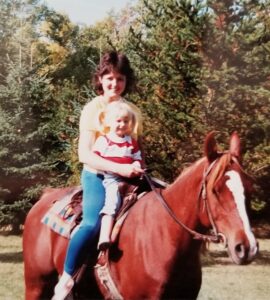
She opened the school house door which opened up into one big room with a giant barrel wood stove at one end. She gave me the tour and showed me where the light switches were; then she proceeded to tell me that I had to come 2 hours before every class. This was to get the fire going in the stove so that the school would be warm enough. You might think that I am either really old or that I’m making it up but I kid you not. I arrived two hours early, got the old stove going, went home, cooked dinner for my family, and then went to teach my very first oil painting class.
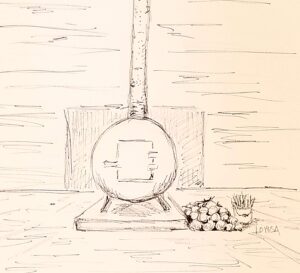
My first class at the schoolhouse brought tears to my eyes afterwards. I was so excited; they enjoyed it and learned a lot. I could actually teach! The painters in my class ranged from 10 to 85. I will always cherish that first experience teaching. Everyone worked on their own subject matter. There was a tiger, several landscapes, a seascape, and people! Oh my gosh, people! I spent a lot of time learning between classes. Learning and sharing. I grew as a teacher and the students grew along with me.

I still learn and then share what I’ve learned. In 1999 I got a call from the Royal Conservatory of Music. I had been recommended by the director of the Rainy River Board of Education as a possible candidate for the “Learning Through the Arts “program. I received a call for an interview, I said “I’m sorry you must have the wrong number. I didn’t apply for a job with the Royal Conservatory.” She responded with, “You came highly recommended, please meet with us so we can tell you what is involved.” I couldn’t believe this was happening. I had volunteered in the schools for a number of years. I had been noticed for my abilities to work with the teachers and the children. Two weeks later I was on my way to Toronto for training. This gave me additional insights into integrating the arts into the school curriculum. My education with the Learning Through the Arts program is so valuable even today. What an amazing experience – and it continues to open many doors for me.
Advice For Becoming an Art Teacher
To become a great teacher, you need to learn to share, to simplify your instruction and, just as important, to use lots of patience when teaching. As a painting teacher you are teaching more than just art. You are teaching your students to see our beautiful world with new eyes. Sometimes you are unaware of how teaching painting might also be affecting your students in other areas of their lives. It can have unexpected social or psychological benefits for your students. If you are passionate about what you do then perhaps you are a teacher too. You just have to give it a try to find out.
Good luck!
Linda Lovisa
‘Use More Paint!’
A Creative Life Reinvents Itself

“I love the outdoors. My paintings are a visual journal of my adventures. They reflect the places I have been and the beauty I have seen. I am drawn by the light, colour and movement in the subjects and scenes I choose. I have been creating for as long as I can remember. My hope is that my art will inspire others to want to create too.” Linda Lovisa
I had a dream. Sometimes you just have to follow your dreams, even against all odds. That is exactly what I did. I opened New Moon Gallery in November of 2009. I was advised it might not be a good time to open a new business; the economy was spiralling downwards at the time. My heart was telling me differently.
I had very big plans for New Moon Gallery. It was exciting! It would be a place to teach and to create works of art. It would also be somewhere to showcase and celebrate art, a creative space for artists to show and share their work with a community that had no art centre. I did just that! It was unique and special.
It began in a small space at Paynter’s Market, then it moved to Dobbin Road, and finally to its 2000 square foot space on Byland Road. Those ten and a half years were both the best of times and the worst of times, but I never gave up. At the end of the day, while closing the door, I would look back into this inspiring place and smile. “This is a good place!” I would say. I always had more to do and share. My students, adults and after-school children, were a huge part of my mission: sharing the joy of creating with as many people as I could. Sharing the joy of seeing the world around us was my passion that kept the gallery alive. It was my determination that was the driving force in trying to instill in a community that the arts are an important part of healthy living. It is in times of need that the arts can be a big part of healing. I have lived this first-hand, and I have seen it for myself over the 25+ years I have been teaching. I am not just talking about visual arts; I mean all art forms. At the gallery there was live music; there were live performances, poetry readings and artists’ talks by those working in different media. I tried as much as possible to include various types of art forms in the gallery so that when you entered its doors you were amazed. I wanted the public to feel at home in its inviting environment. I wanted them to know that they could come anytime for a tea or a coffee to talk about art and to enjoy the ambiance. It was a place to educate others about artists: What it takes to become an artist. How each artist pours heart and soul into what they do. Sharing my love of the arts was my joy. I was living my dream every day. On April 30, 2020, New Moon Gallery closed its doors for the last time.
May 1, 2020, a new day, a new beginning and new direction. I was still reeling over the closure of the gallery, but I had an unusual saviour to keep me smiling and thinking about the future.
On December 26, 2019, a goose was born. It all came about in an interesting way. I had the most amazing Christmas at the gallery, and the new year was looking very good. Our Christmas with family and friends was full of love and thankfulness. All of the celebrating had occurred and Boxing Day was a quiet day at home. I had not painted in weeks as the gallery was busy, so there was very little time to create. I was so excited finally to sit down and paint. My son and I had a conversation about doing some cards for the gift shop at Big White Ski Resort. He lives up there and he had spoken to the shop manager; she welcomed the idea. I thought about doing my usual winter watercolours, but on that day I was feeling especially playful and thought about a Canada Goose on skis! I had so much fun creating the four images. I shared them with my son, he laughed out loud and said, “Mom, there is a story there.” I shared the images with friends and they said the same thing. So, how does a Canada Goose end up skiing? What’s his name? It was like naming a child. My husband and I thought it had to be a G name or a C name. The search began, and Gordon the Canada Goose was born.
The story begins: Gordon lives in the Okanagan Valley in British Columbia, Canada. There are vineyards, orchards and small farms all around Lake Okanagan. The farmers are busy harvesting fruits and vegetables. Fall is in the air; leaves are changing colour and Gordon is very excited about the journey south.

The first colourful page shows the valley with vines and orchards in the foreground and a snowy mountain in the distance. The page is bordered with fruits and vegetables, which are planned to strike a conversation with the young listener or reader. Creating the story was so much fun. I used some skiing experiences that most people have when they learn to ski. One thing led to another, and the next thing you know there are 58 paintings and a story that is entertaining. The prototype was ready to pick up at the printer’s on the eighth of May, 2020. I was so excited to see the book, to feel the book and leaf through the pages. I was in tears. There was so much emotion. I could not believe I had created this children’s book. I could hardly wait to share it. I had so many more stories to tell. So, the book “Gordon Goes Skiing” is the first in a series of books under the name of The Adventures of Gordon the Canada Goose. I am currently writing and illustrating book two of The Adventures of Gordon the Canada Goose. In the story Gordon and his friend Marty head up Carrot Mountain to see if there are carrots on Carrot Mountain.
I also published a second book in October 2020. I had written a winter poem years ago that I had always wanted to illustrate, so I busied myself creating the images for Winter Came Softly. It was released just in time for Christmas. It is a completely different book than the Gordon book. 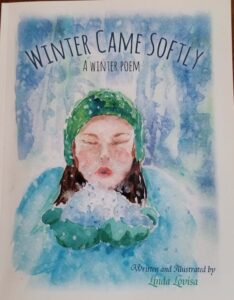
I find it hard to believe that I have been creating for 50 years. I still have so much to do. I truly believe I will be creating on the way to my grave (laughing out loud). Currently, I am continuing my virtual teaching with adults via Zoom as well as in-person outdoor sessions with my after-school students. I am painting a series in acrylics, continuing to create with watercolour and am writing two more books. Do I miss my gallery? Yes, I do. I miss the people and their art. I miss art lovers. Will I open another gallery? Not likely, I lived that dream. Now I’m on to the next dream. The creative mind never really stops. What is the next idea? How do I create that? As an artist I am always learning. Nothing is perfect in our world. There is always something to strive for. All it takes is one step. It just takes the will to try something new. Let the arts excite you and bring you joy. Create for you first – that has always been my motto. I am so happy that I have art in my life
This article was originally published in the Summer 2021 issue of Sage-Ing.
Art For Change
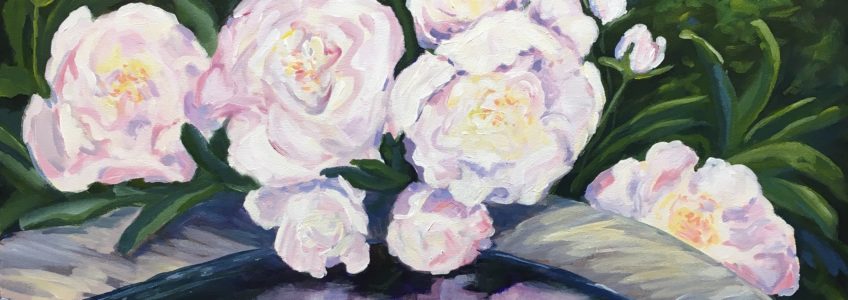
Born to Change
We are all naturally born to create. But somehow we define art, and creation as something only for those who are naturals or are born with talent.
Being naturally born to create, it’s what you do with that energy as you grow: you can grow into it, or grow away from it. I see with many of my students that if you grow away from it, someday it will call you back. Perhaps you feel or felt that life is too busy to create (you know, the kids, working full time, never any time for yourself, and so on). There were a million reasons that there wasn’t time and time trickled away.
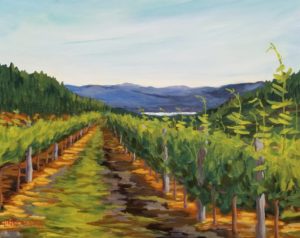
A day comes along that finds you searching for what has been missing.
You wake up and realize that it is your yearning to create. It is the arts.
There is a longing for creative expression in all of us. It could be any one of the many art forms available at your fingertips writing, music, dance, theatre, or the visual arts. In your search, you will discover a whole new world out there. All of your senses will be awakened. You’ll notice colours that have been around you all your life! The music created by the wind gently blowing through the trees makes you pick up a pen to write a line or two. The sound of a certain guitar reminds you, I’ve always wanted to play.
The urge will come when you least expect it. There will be a day when you begin to explore how you’d like to express your creative self. It’s never too late. There is an urgency to start your journey now. Leaving behind thoughts like, I have no talent, you must ask yourself if you have really searched and tried to create? It’s your journey and your job to look and find where your talent lies. Enjoy the journey that the exploration brings. You will surprise yourself!
Maybe your path doesn’t lead to theatre or music; it could be calligraphy or photography. Perhaps it’s more than one discovery that leads you into illustration, writing and creating your own book!
Reflections: an Inspiration Journal
A new book is what I created. The title is Reflections: an Inspiration Journal. It’s due out mid-September, 2012.
Over the years, experience with my own sketchbooks and journals found me doodling in both. My idea for the book was to produce a collection of favourite works and moments. The journal has explorations that foster creativity with prompts and inspirational thoughts. Each painting is followed with blank pages where the readers can create and develop their own working journal. Twenty of my paintings are inserted throughout the journal with my inspiration for that painting, techniques and prompts for you to explore. The book reflects the teaching in my art classes.
Reflections: an Inspiration Journal is designed to inspire creativity in a number of ways: creative writing, collage, photographs, sketching with ink, pencil, charcoal or watercolours. A lot of thought was put into the construction of the book. Its size, 8”x 8”, and spring binding allows this journal to function as a portable workbook. It’s not dated, so you can work through it at your own pace.
Cross Pollinating Creativity
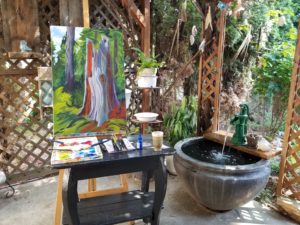 The wonderful thing that happens in the arts is that you discover one area and it leads into more and more. The arts weave one into the other. It’s magical. There are areas to grow when you thought you’ve done it all. What a feeling! Invigorating! Creation brings a renewed excitement to everyday life. It’s something to look forward to and lose yourself in. The creative way to wellness is guilt free. You deserve to treat your brain, your body, your inner self and the soul in a respectful way, remembering that we are all born with talent and to be creators. It’s up to you to find your way! Start by putting art into your daily routine, like having your morning coffee or walking the dog.
The wonderful thing that happens in the arts is that you discover one area and it leads into more and more. The arts weave one into the other. It’s magical. There are areas to grow when you thought you’ve done it all. What a feeling! Invigorating! Creation brings a renewed excitement to everyday life. It’s something to look forward to and lose yourself in. The creative way to wellness is guilt free. You deserve to treat your brain, your body, your inner self and the soul in a respectful way, remembering that we are all born with talent and to be creators. It’s up to you to find your way! Start by putting art into your daily routine, like having your morning coffee or walking the dog.
New Moon Art Gallery
Linda Lovisa owns New Moon Gallery and Natural Transitions Art Studio in West Kelowna, British Columbia. She is a visual artist who works full-time painting and teaching in her studio. Linda promotes local area artists in her gallery while sharing her talents in various mediums, including acrylics, watercolours and pastels. Classes are offered all year round in the studio. Please stop by the gallery for information or check her web site at www.newmoonartgallerykelowna.com. Reflections: An Inspirational Journal will be available online for pre-sales and at the New Moon Gallery midSeptember. You can reserve your copy at the Gallery or through Linda’s website. Linda is pleased to be participating in ArtWalk 2012. Please stop by to say hello!
